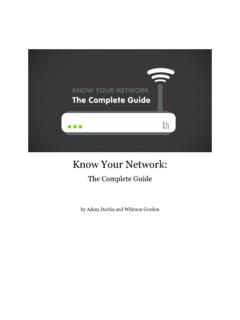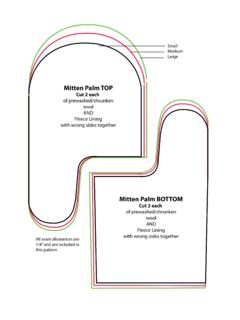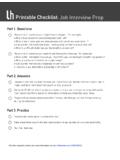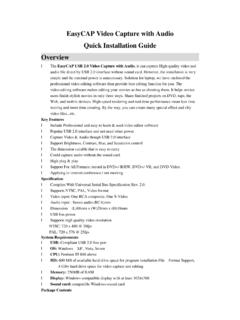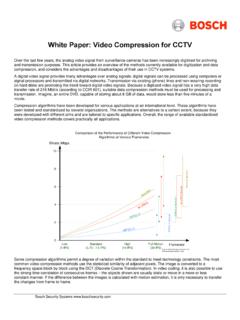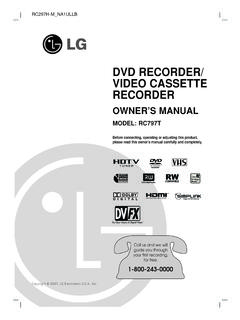Transcription of The Basics of Video Editing: Notes - toasterdog
1 The Basics of Video editing : NotesThe Basics of Video editing Part I: Getting to Know Your editing Environment Adam Dachis If you've edited a few videos but have always wanted to step up your game and learn to edit with professional software, now's your chance. We'll be taking a dive into the Basics of professional Video editing software all week. First up: a look at editing environments, the purpose of everything on your screen, and how to do a few basic YOU! This is going to be a little intimidating at first if you have zero to little experience with professional editing software. Don't worry.
2 This first lesson is here to get you acquainted with all the stuff you see on your screen, explain how a few things work, and get you more comfortable before actually doing much of anything. In subsequent lessons, we'll look at creating a project from scratch, color correction, effects, and more. Video editing with professional software is actually very easy but it's just intimidating because of all the buttons and options. Once you know what things are and have the Basics down, you'll be able to do all sorts of great things. While these lessons will deal primarily with Final Cut Pro, we'll also be exploring Adobe Premiere as a means of demonstrating how the lessons are really applicable to pretty much and professional Video editing software.
3 Even if you're not using Final Cut Pro, stick with it as we'll be addressing concepts and techniques that are useful in pretty much any editing , let's get to it!The Video above is the lesson, so be sure to watch it. The Basics are probably the biggest hurdle to overcome simply because of the sheer number of options you have, but by the end of the week we should have you in really good shape and able to do the majority of what you'd want to do with professional editing software. You'll need to watch the Video to get a good representation of everything, but the following Notes can serve as a cheat sheet to refer to as we go File BrowserAny idea what the File Browser might do?
4 The name is kind of self-explanatory but that doesn't mean there's nothing you need to know about it. While it may not be called the file browser in every editing application (it may be called the assets browser, for example, or something else), there is some window you're going to see that will help you manage your assets. Assets have a wide range of types. You can generally import Video , audio, still images, and sometimes even motion graphics projects (depending on your editing software's capabilities and tie-ins with other applications) into your file browser. You'll also be able to create Bins, which are basically folders (and often look like them, icon-wise), that will help you organize your most important things you'll be able to create, however, are Sequences.
5 Sequences store your edits, and you can have a bunch of them. Basically, you edit a bunch of Video within a sequence and then export that sequence to a format of your choosing. You can also create sequences that contain other sequences. Why would you do this? Well, if you're editing a movie and you want to edit scene by scene, you could make a sequence for each scene. When you're done editing all the scenes, you want them to be in one big sequence so you can watch the entire thing at once. To do this, you can just put all the individual scene sequences together in one master sequence and you've got your movie.
6 This is useful 1) because sequences sometimes get pretty slow when you've got a ton of stuff in them, and 2) you can also more easily make changes to a scene without disrupting everything else. It's kind of likeusing variables in file browser stores all of these things and will be a very useful tool as you ViewerThe Viewer is one of two Video windows you have on your screen and it's traditionally on the left side. The viewer is what you use to preview clips, apply edits to those clips globally (we'll talk about what this means in a minute), create effects, and apply filters and transitions.
7 Basically, it's where you do the gritty work. The Canvas, which will talk about next, is where you see the final product as laid out on your Timeline (which we'll talk about after we talk about the Canvas).Okay, so how does the viewer work? When you open a clip in the file browser, you'll see it in the viewer. You can choose in and out points for that clip that'll be globally applied any time you use that footage. This means that if you set an in and out point to shorten the length of the Video clip, when you add it to your edit timeline it will always appear to be that shortened length.
8 If you are to make changes to it once it's on the timeline, however, those edits will not carry over if you add that same footage to the timeline again. Basically, what happens in the viewer happens everywhere and what happens in the timeline stays in the timeline. To look at it from the timeline's perspective, if you want to make alterations to a clip that's already on the timeline you can generally do this in the viewer as well. Those edits will apply only to the instance of the clip on the timeline. Those edits will not carry over to the original footage in your file viewer is also where you'll most likely edit your effects, transitions, and filter settings.
9 If you're color correcting, the color corrector will likely show up in the space designated for the viewer. If you're editing the length of a crossfade transition, it'll happen here too. This isn't always the case with every Video editing software, but it's the normal location. In a future lesson on effect, we'll get into this more. For now, just remember the viewer is where clip-specific edits take CanvasThe Canvas is the other one of the two Video windows and it's traditionally on the right side. The canvas is very simple to understand. It looks a lot like the viewer, but it's job is simply to display the frame you're currently on in the timeline.
10 It's where you view your edit as it currently stands. In my opinion, it seems like more of a viewer than the viewer, but what can you do. That's pretty much all there is to TimelineThe Timeline is where you do your editing . You plop clips on the timeline in the order you want them to appear, you can layer them to have multiple streams of Video and audio playing back at once, and you can edit things to flow the way you want. In the timeline you'll have access to a few tools, but you'll mainly use an arrow tool and a (razor) blade tool. The arrow is for picking up stuff and moving it around on the timeline.

